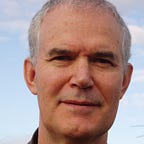MONEY AND OUR THREE ECONOMIES
Our Three Economies
The Real Economy
The economy in which goods and real property are created and traded and services provided for money.
The Financial Economy
The economy in which securities are created and traded.
The Unpaid Economy
The economy in which people perform valuable work for no pay.
The ‘unpaid economy’ includes learning; minding the home; caring for children, the elderly and incapacitated; as well as undertaking volunteer work, and unpaid creative work and social interaction that provides value to the community and meaning to our lives. On some accounts, if all transactions were priced, this economy would be as large as the real economy. In fact, much of the work is priceless, as without people performing it, the real economy could not function.
Money and Growth in the Real Economy
Money is just a crude ‘measure of value’ and a ‘tool for allocating resources’.
It allows us to (roughly) measure the value contributed through work and investment, so we can take out (roughly) the same value when we spend it.
Buyers (private, business, and public) use money as a ‘tool’ to direct activity as they spend it to satisfy individual, organizational and community needs.
In order for money to provide a consistent measure, the amount on issue needs to remain in ‘dynamic balance’ with the capacity of the community to produce goods and services. Too much, and we get inflation. Too little, and we get recessions and depressions.
On the other hand, the economy cannot grow unless extra money is injected to signal extra demand.
The trick is getting the net flow of money into the real economy just right.
How Money Flows Into and Out of the Real Economy
Most money is created by banks as they make loans to individuals, businesses and government. It is destroyed as the loans are repaid.
This is not my contention. The process is explained by the Bank of England.
In simple terms, your bank never asks if it can lend out your deposit. Instead, when a new borrower is approved, the bank simply makes two entries in its books. On one side they show the amount of money borrowed that must be repaid; matched on the other side by a new deposit, that the borrower can draw down.
The double entries create ‘money out of thin air’ while keeping the bank’s books in balance.
Inflows:
- Each borrower spends the new money into the economy, boosting demand for goods and services.
- Some money also comes in from overseas via visitors and investors.
Outflows:
- As a borrower works/invests to create additional value, they earn money which allows them to repay the loan. As the loan is repaid, the entries in the books of the bank are reversed, and the money is written back into the ‘thin air’ from which it came, taking money out of the economy.
- Government surpluses also extract money from the real economy.
- As do overseas remittances.
- As well, a large percentage of higher salaries and profits, as well as superannuation contributions, is channeled from the real economy into the financial economy.
To keep the economy stable, as money is taken out, it must be replaced by a combination of new individual, business or government borrowing and external inflows.
For the real economy to grow, the amount of money flowing in must exceed the amount flowing out; which means that over time, total debt must grow.
How Money Flows Into and Out of the Financial Economy
Money flows into the financial economy in three ways:
- Banks create money that is loaned and spent into the financial economy.
- Central Banks use Quantitative Easing (QE) to create money that is used to buy securities
- Money is channeled from the real economy.
Money flows out as:
- Investors liquidate securities to repay loans
- Central Banks sell the securities they bought, or
- As securities mature and the money is repaid to the Central Bank
Once circulating in the financial economy, money rarely ‘trickles back down into the real economy’.
Managing the Flow of Money
Central Banks try to manage the flow of money overall using the ‘cash rate’.
In theory, a rise in the cash rate should depress the demand for new loans, reducing the amount of new money flowing into both ‘economies’, while a fall in the rate should promote borrowing, and hence demand for goods, services and securities.
In practice, there are some major shortcomings with the current system.
These include moral hazard, and the fact that the cash rate has ceased to be an effective control measure. Also, as there are no limits on the amount that can be injected into the financial economy, once QE is started it cannot be easily unwound without collapsing the financial markets. QE is largely responsible for the rise and rise in securities prices disconnected from the real economy; most clearly evidenced in the contrary effects of the current pandemic: stock market up while businesses collapse and millions lose their jobs!
